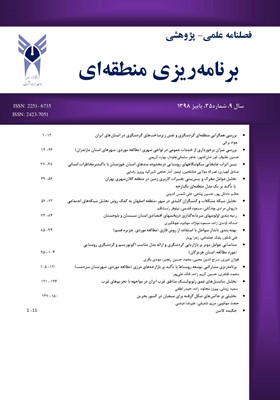برنامه ریزی و طراحی بسترهای گیاهی هوشمند در شکل کشاورزی عمودی خانگی در فضاهای مسکونی و شهری ایران
محورهای موضوعی : فصلنامه علمی برنامه ریزی منطقه ایجانا عرب زاده 1 , حسن بلخاری قهی 2 , سید مجید مفیدی شمیرانی 3 , ایرج اعتصام 4 , آزاده شاهچراغی 5
1 - دانشجوی دکتری معماری، ، دانشگاه آزاد اسلامی، واحد علوم و تحقیقات، تهران، ایران.
2 - استاد گروه مطالعات هنر، دانشکده هنرهای تجسمی، پردیس هنرهای زیبا، دانشگاه تهران، تهران، ایران.
3 - استادیار شهرسازی، دانشگاه علم و صنعت ایران، تهران، ایران.
4 - استادگروه معماری، دانشگاه آزاد اسلامی، واحد علوم تحقیقات، تهران، ایران.
5 - دانشیار گروه معماری، دانشگاه آزاد اسلامی، واحد علوم و تحقیقات، تهران، ایران.
کلید واژه: طراحی زیست دوست, کشاورزی عمودی خانگی, کشاورزی شهری, دیوار زنده گیاهی,
چکیده مقاله :
فناوری کشاورزی عمودی خانگی از دستاوردهای مشترک معماری زیست دوست و کشاورزی است. اهداف کشاورزی شهری علاوه بر تولید محصولات کشاورزی خانگی جهت تامین امنیت غذایی در شاخه بهداشت اقتصادی خانوار، دوستی با طبیعت می باشد. هدف پژوهش،برنامه ریزی عملکرد طراحی بسترهای سبز هوشمند در قالب کشاورزی عمودی خانگی جهت تولید برخی محصولات کشاورزی در خانه و سالم سازی محیطی در جغرافیای ایران می باشد. پژوهش از نظر هدف کاربردی و از نظر روش کمی و پیمایشی است. داده های پژوهش ابتدا، پس از تحلیل محتوای نمونه مطالعات موردی اجرا شده جهانی قابل تطبیق با اقلیم ایران، از منابع دست اول انتخاب شد؛ملاک های اندازه اثر، اطلاعات کافی برای پژوهش کمی، روش نمونه گیری و آماری صحیح و روایی و پایایی مدنظر قرار گرفت . شش مولفه براساس جنبه های نظری ویژه انتخاب شد، روایی مولفه های فوق با نظر اساتید و متخصصان کشاورزی و برنامه ریزی معماری تایید شد. برمبنای مولفه های به دست آمده، پرسش نامه ساختاریافته ای بین اعضای نمونه، به عنوان پیش آزمون توزیع شد.پس از ورود داده ها با نرم افزار spss، ضریب آلفای کرونباخ 948 % محاسبه گردید. پرسش نامه با پایایی میان صد نفر از مهندسین کشاورزی و اقتصاد کشاورزی سازمان جهاد کشاورزی توزیع گردید. نتایج آزمون tتک نمونه ای، این فناوری را موثر در بهبود بحران های مطرح شده و عاملی برای ارتقا کیفیت زندگی ارزیابی نمود. از آزمون فریدمن جهت مقایسه مولفه های کشاورزی عمودی خانگی استفاده شد. با فناوری کشاورزی عمودی خانگی می توان اطلاعات سودمندی در زمینه برنامه ریزی طرح و توسعه شیوه های اجرایی کشاورزی عمودی خانگی، در زیستگاه های شهری بدست آورد.
The technology of vertical farm for residential Buildings, is a common achievement of Biophilic architecture and Agriculture. The main goal of Urban Agriculture beside producing homemade crops to reach household economical hygiene via food security, is friendship with nature. The aim of this research is planning and evaluating smart vegetated surfaces necessity of House vertical farms, to produce some of crops in residential spaces, and hygiene environments of Iran. The study’s aim is practical and the methodology is quantitative- survey. The study’s data, were chosen between the first hand references that criterion could be adaptive to Iran climate situation; sufficient information for an appropriate qualitative study, correct statistical method and validity and reliability were mentioned. Six compilation throughout the theoretical aspects were chosen. The validity were proved by the Agriculture and Architectural planning professors. According to the obtained compilations, a researcher-made questioner have been distributed as pre exam between few members. After entering data with spss software the alpha’s Cronbach coefficient were 0.948; the reliable questioner were distributed between 100 agriculture engineers and agriculture economic engineers of Ministry Agriculture of Jihad. The results after t and t-sample test evaluated this technology efficient to mentioned crisis betterment, and a factor to improve quality of life. Friedman test were used in order to compare House vertical farm compilation. The approve of the agriculture economic engineers with the residential vertical farm technology, and the relation between the mentioned measurements and compilations, could consider suitable information for planning and developing the implementation of House vertical farm in urban habitant.
_||_


